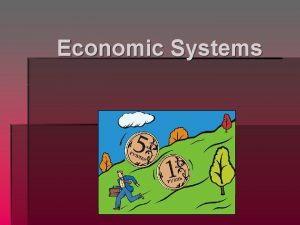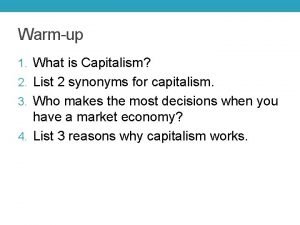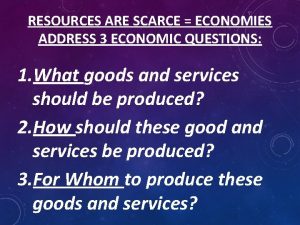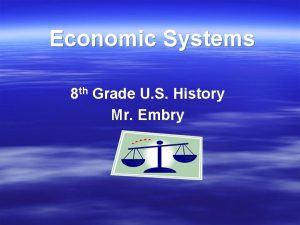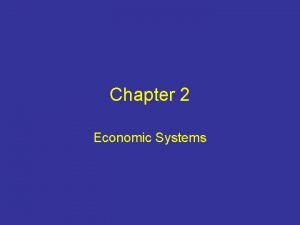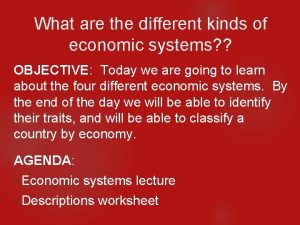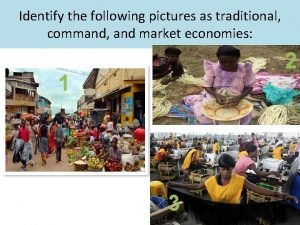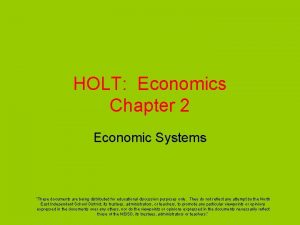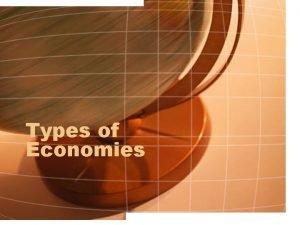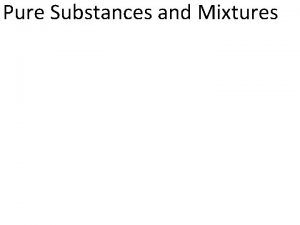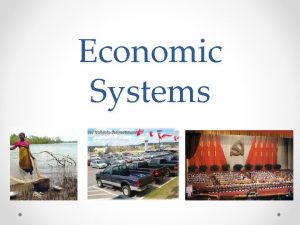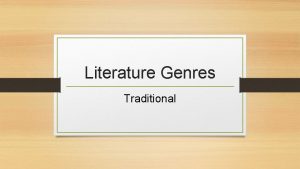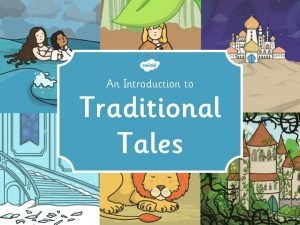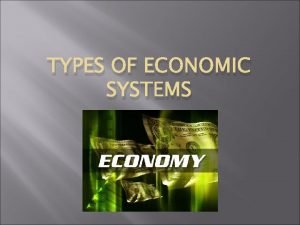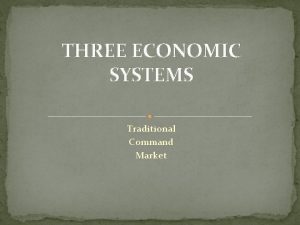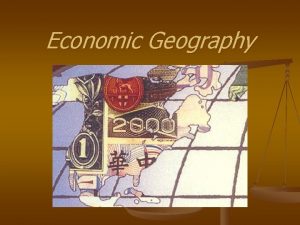Traditional System A pure traditional economy answers the
















- Slides: 16

Traditional System A pure traditional economy answers the basic economic questions according to tradition. Things are done as they were in the past based on tradition, customs, and beliefs (religious). Examples: Certain areas in developing countries

What to produce? By custom. Whatever was produced in the past.

How to produce? By custom. However items were produced in the past.

For whom to produce? By custom. Whoever usually received products will again receive them.

Command System The individual has little influence over how the economic questions are answered in a pure command system. The government controls the factors of production and makes all decisions This cold be one person, a small group, or central planners who decide what resources to use at each step of production and the distribution of goods and services The government even decides the role everyone will play Examples: North Korea and Cuba

What to produce? The government decides what should be produced. The government owns most of the means of production.

How to produce? The government does the planning for production: factory locations, the occupations of workers and their salaries.

For whom to produce? The government controls the distribution system for goods/services: housing, transportation, consumer items and sets prices.

Market System Capitalism is a pure market economy. In this system the government does not intervene. Individuals own the factors of production and they decide the answers of the basic economic questions. The market is the freely chosen activities between buyers and sellers of goods and services. Examples: the underground economy, 19 th century Britain

What to produce? Consumer choices dictate the success of goods/services.

How to produce? Business leaders choose the means of production. Their goal is the most efficient and profitable methods

For whom to produce? The consumers’ income determines who receives which goods/services

Mixed Economic System Many economists doubt that a pure economic systems ever existed. A mixed economic system contains elements of the market and command systems, with elements of traditional as well. For example, there is some private ownership in the Peoples’ Republic of China. Some private ownership also existed in the former Soviet Union. Examples: United States, most other nations

Characteristics of the United States Mixed Economic System Not all decisions are made by individuals reacting to the market. Federal, state, and local governments make laws regulating some areas of business.

Public & private sectors contribute to the economy in varying proportions. For example, federal defense spending can boost the economy; the Postal Service is a quasigovernmental corporation. Government steps in to handle inequities in the system. Many social/welfare programs were created during the 1930 s. Traditional celebrations like Christmas affect portions of the economy.

Factors of Production Land Natural resources (ex. Water, sun, oil) Capital Tools, equipment, etc. used in production of goods & services Labor Peoples’ efforts, skills Entrepreneurs Someone with new ideas, risk taker
 Which statement best describes a pure market economy?
Which statement best describes a pure market economy? Athens and sparta were both
Athens and sparta were both Traditional economy cons
Traditional economy cons Traditional economy
Traditional economy Traditional economy definition economics
Traditional economy definition economics Traditional economy definition economics
Traditional economy definition economics Scarcity political cartoon
Scarcity political cartoon Traditional economy advantages
Traditional economy advantages Traditional economy advantages
Traditional economy advantages Traditional economy
Traditional economy Command economy pictures
Command economy pictures Traditional economy definition economics
Traditional economy definition economics Three types of economies
Three types of economies Traditional economy
Traditional economy Continuum
Continuum Are entrepreneurs encouraged in a traditional economy
Are entrepreneurs encouraged in a traditional economy Traditional economy meaning
Traditional economy meaning
